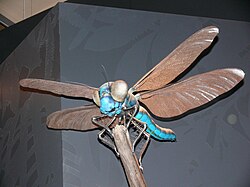User:Abyssal/Portal:Carboniferous
IntroductionThe Carboniferous (/ˌkɑːrbəˈnɪfərəs/ KAR-bə-NIF-ər-əs) is a geologic period and system of the Paleozoic era that spans 60 million years from the end of the Devonian Period 358.86 Ma (million years ago) to the beginning of the Permian Period, 298.9 Ma. It is the fifth and penultimate period of the Paleozoic era and the fifth period of the Phanerozoic eon. In North America, the Carboniferous is often treated as two separate geological periods, the earlier Mississippian and the later Pennsylvanian. The name Carboniferous means "coal-bearing", from the Latin carbō ("coal") and ferō ("bear, carry"), and refers to the many coal beds formed globally during that time. The first of the modern "system" names, it was coined by geologists William Conybeare and William Phillips in 1822, based on a study of the British rock succession. Carboniferous is the period during which both terrestrial animal and land plant life was well established. Stegocephalia (four-limbed vertebrates including true tetrapods), whose forerunners (tetrapodomorphs) had evolved from lobe-finned fish during the preceding Devonian period, became pentadactylous during the Carboniferous. The period is sometimes called the Age of Amphibians because of the diversification of early amphibians such as the temnospondyls, which became dominant land vertebrates, as well as the first appearance of amniotes including synapsids (the clade to which modern mammals belong) and sauropsids (which include modern reptiles and birds) during the late Carboniferous. Land arthropods such as arachnids (e.g. trigonotarbids and Pulmonoscorpius), myriapods (e.g. Arthropleura) and especially insects (particularly flying insects) also underwent a major evolutionary radiation during the late Carboniferous. Vast swaths of forests and swamps covered the land, which eventually became the coal beds characteristic of the Carboniferous stratigraphy evident today. The later half of the period experienced glaciations, low sea level, and mountain building as the continents collided to form Pangaea. A minor marine and terrestrial extinction event, the Carboniferous rainforest collapse, occurred at the end of the period, caused by climate change. Atmospheric oxygen levels, originally thought to be consistently higher than today throughout the Carboniferous, have been shown to be more variable, increasing from low levels at the beginning of the Period to highs of 25-30%. (Full article...) Selected natural world article
The annelids are a large phylum of segmented worms, with over 2,000 modern species including ragworms, earthworms and leeches. They are found in marine environments from tidal zones to hydrothermal vents, in freshwater, and in moist terrestrial environments. The basic annelid form consists of multiple segments, each of which has the same sets of organs and, in most polychaetes, a pair of parapodia that many species use for locomotion. Septa separate the segments of many species, but are poorly defined or absent in some. Septa also enable annelids to change the shapes of individual segments, which facilitates movement by "ripples" that pass along the body or by undulations. Although many species can reproduce asexually and use similar mechanisms to regenerate after severe injuries, sexual reproduction is the normal method in species whose reproduction has been studied.
Since annelids are soft-bodied, their fossils are rare – mostly jaws and the mineralized tubes that some of the species secreted. Although some late Ediacaran fossils may represent annelids, the oldest known fossil that is identified with confidence comes from about 518 million years ago in the early Cambrian period. Fossils of most modern mobile polychaete groups appeared by the end of the Carboniferous, about 299 million years ago. Scientists disagree about whether some body fossils from the mid Ordovician, about 472 to 461 million years ago, are the remains of oligochaetes, and the earliest certain fossils of the group appear in the Tertiary period, which began 65 million years ago. (see more...) Did you know...
Need help?Do you have a question about Abyssal/Portal:Carboniferous that you can't find the answer to? Consider asking it at the Wikipedia reference desk. Selected image
Selected science, culture, or economics articleBradford Colliery was a coal mine on the Central Manchester Coalfield in Bradford, Manchester then in the historic county of Lancashire, England. Although part of the Manchester Coalfield, the seams of the Bradford Coalfield correspond more closely to those of the Oldham Coalfield. The Bradford coalfield is crossed by a number of fault lines, principally the Bradford Fault, which was reactivated by mining activity in the mid-1960s. Coal had been mined at Bradford since at least the early 17th century, when the area around the pits was largely rural; it became increasingly built-up and industrialised as nearby Manchester expanded during the 19th century. Coal was transported from the colliery by canal and railway, but most was consumed locally by the adjacent Bradford Ironworks. In the mid-20th century a 469-yard (420 m) underground tunnel was dug to supply coal directly to the Stuart Street Power Station. Damage to buildings in the area around the colliery caused by subsidence led to it becoming uneconomic despite its sitting on large reserves of high-quality coal, and it was closed in 1968. The site was cleared and is now occupied by the City of Manchester Stadium. (see more...) GeochronologyEpochs - Mississippian - Pennsylvanian Landmasses - Gondwanaland - Laurasia - Pangaea Fossil sites - Bear Gulch Limestone - Hamilton Quarry - Mazon Creek fossil beds Researchers - Alfred Sherwood Romer
SubcategoriesQuality ContentFeatured Carboniferous articles - Amphibian Things you can doRelated contentAssociated WikimediaThe following Wikimedia Foundation sister projects provide more on this subject:
|





















